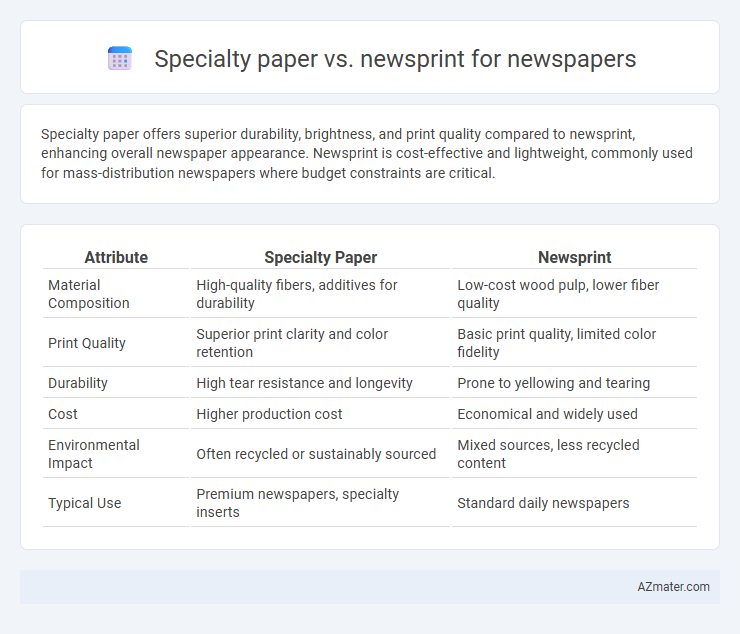Specialty paper offers superior durability, brightness, and print quality compared to newsprint, enhancing overall newspaper appearance. Newsprint is cost-effective and lightweight, commonly used for mass-distribution newspapers where budget constraints are critical.
Table of Comparison
| Attribute | Specialty Paper | Newsprint |
|---|---|---|
| Material Composition | High-quality fibers, additives for durability | Low-cost wood pulp, lower fiber quality |
| Print Quality | Superior print clarity and color retention | Basic print quality, limited color fidelity |
| Durability | High tear resistance and longevity | Prone to yellowing and tearing |
| Cost | Higher production cost | Economical and widely used |
| Environmental Impact | Often recycled or sustainably sourced | Mixed sources, less recycled content |
| Typical Use | Premium newspapers, specialty inserts | Standard daily newspapers |
Introduction to Newspaper Printing Materials
Newsprint is a low-cost, lightweight paper primarily used for mass-market newspapers due to its brightness and ink absorbency, facilitating quick drying and clear text reproduction. Specialty paper, featuring higher durability and enhanced print quality, is often selected for premium or niche publications to improve color vibrancy and tactile experience. Selecting between newsprint and specialty paper directly impacts print quality, durability, and overall reader engagement in newspaper printing.
What is Specialty Paper?
Specialty paper for newspapers is engineered with enhanced durability, superior print quality, and specific functional properties such as gloss, opacity, and moisture resistance, distinguishing it from standard newsprint. It often incorporates additives and coatings to improve ink absorption and prevent bleed-through, resulting in sharper images and text clarity. This type of paper supports advanced printing technologies and offers better longevity, making it ideal for premium or niche publications demanding higher visual appeal and tactile experience.
What is Newsprint?
Newsprint is a low-cost, non-archival paper primarily made from mechanical pulp, designed specifically for high-speed, large-volume newspaper printing. It features a lightweight, porous texture that allows for fast ink absorption, ensuring clear and legible text and images. Compared to specialty paper, newsprint offers an economical solution with sufficient durability for short-term use and daily circulation.
Paper Quality and Print Clarity
Specialty paper offers superior paper quality with enhanced durability and a smoother surface, which significantly improves print clarity and color vibrancy in newspapers. Newsprint, being more economical and lightweight, often results in lower resolution images and faster wear, impacting overall readability. Choosing specialty paper ensures sharper text and richer graphics, elevating the reader experience despite higher production costs.
Cost Comparison: Specialty Paper vs Newsprint
Specialty paper typically incurs higher production and material costs compared to newsprint due to its enhanced durability, brightness, and print quality. Newsprint is cost-effective, primarily made from inexpensive wood pulp and recycled fibers, making it the preferred choice for large-volume newspaper print runs on a tight budget. Publishers weigh the premium expenses of specialty paper against newsprint's affordability to balance print quality with overall expenditure.
Environmental Impact and Sustainability
Specialty paper for newspapers often uses recycled fibers and environmentally friendly coatings that enhance durability and reduce chemical waste, making it a more sustainable choice compared to traditional newsprint. Newsprint, typically made from virgin wood pulp, has a higher environmental footprint due to deforestation and greater water and energy consumption during production. Choosing specialty paper supports circular economy practices by promoting reuse and reducing landfill waste associated with conventional newsprint disposal.
Durability and Lifespan of Printed Newspapers
Specialty paper offers significantly enhanced durability and longer lifespan for printed newspapers due to its higher fiber quality and improved coating technology, which resists yellowing and tearing. Newsprint, primarily made from recycled fibers, tends to be more susceptible to degradation, fading, and brittleness over time. This difference in material composition makes specialty paper ideal for archival purposes and premium publications requiring extended preservation.
Reader Experience and Aesthetic Appeal
Specialty paper enhances reader experience with smoother texture, higher brightness, and sharper image reproduction, making text and visuals more engaging and easier to read. Newsprint, while cost-effective and widely used, often produces less vibrant colors and a coarser feel, which can detract from aesthetic appeal and readability in long-form content. Newspapers aiming for premium presentation and durability typically prefer specialty paper to elevate the overall quality and attract discerning audiences.
Suitability for Different Newspaper Types
Specialty paper offers enhanced durability, brightness, and print quality, making it ideal for high-end magazines, supplements, and color newspapers where visual appeal is crucial. Newsprint, characterized by its lightweight, low-cost, and fast absorption properties, suits daily newspapers and bulk circulation publications prioritizing affordability over longevity. Different newspaper types leverage these materials based on budget constraints, target audience, and the desired balance between print quality and cost efficiency.
Choosing the Right Paper: Key Considerations
Specialty paper offers superior brightness, durability, and print quality compared to newsprint, making it ideal for high-end newspapers requiring vivid images and longer shelf life. Newsprint remains the cost-effective choice for mass circulation with quicker production times and adequate print clarity for standard text and images. Key considerations include budget constraints, desired print quality, production speed, and environmental impact, as specialty papers often use recycled fibers and sustainable manufacturing processes.

Infographic: Specialty paper vs Newsprint for Newspaper
 azmater.com
azmater.com